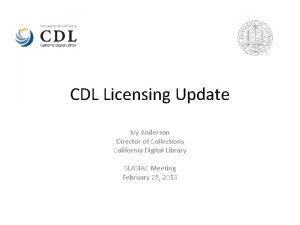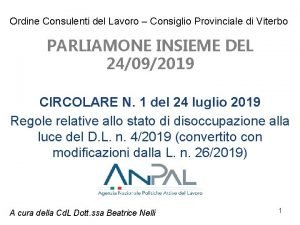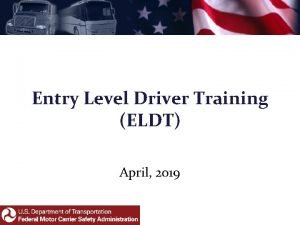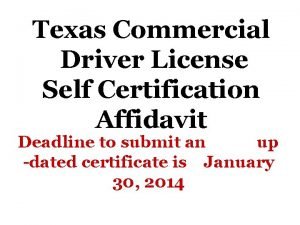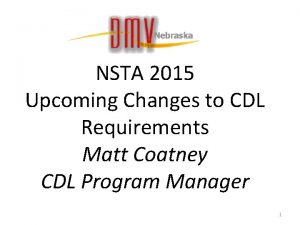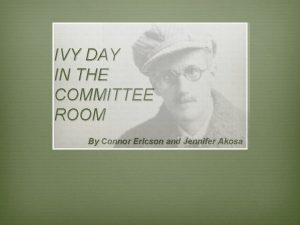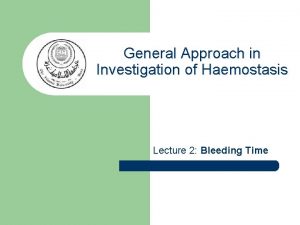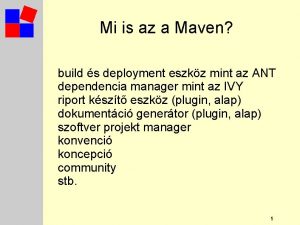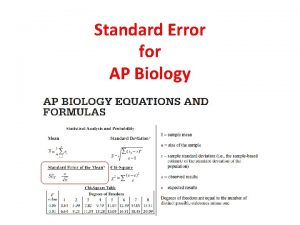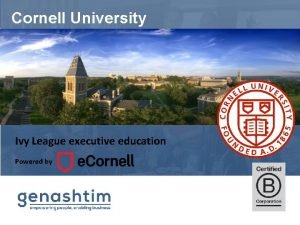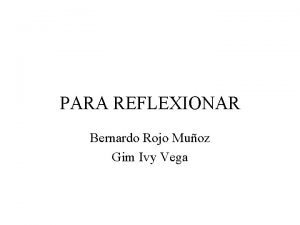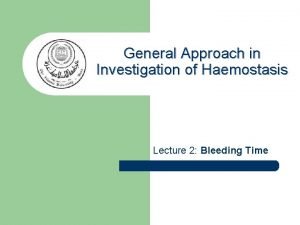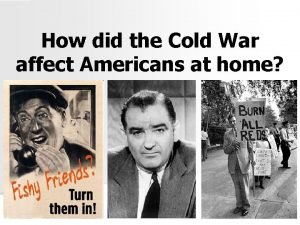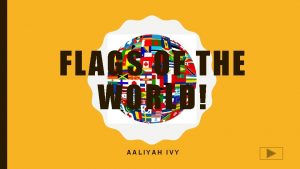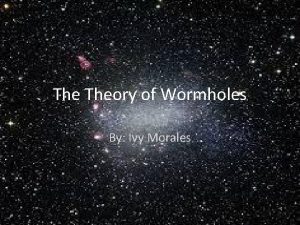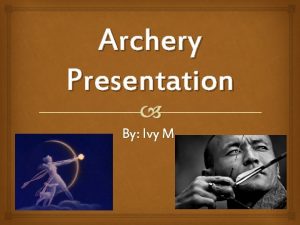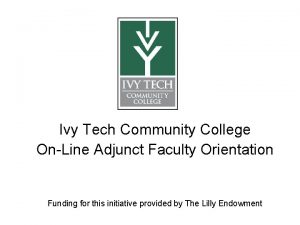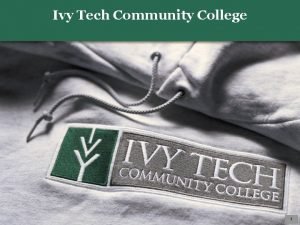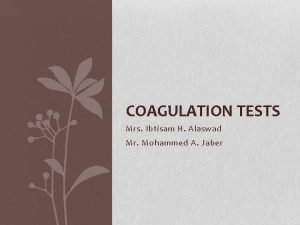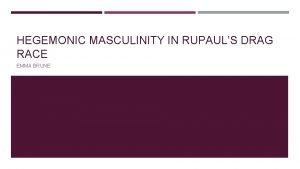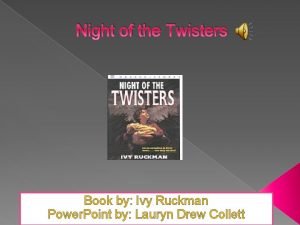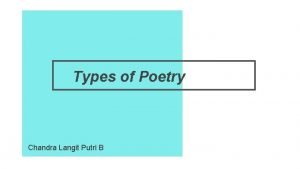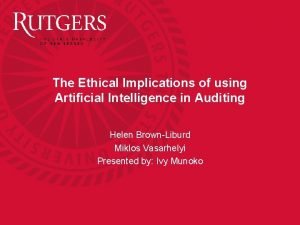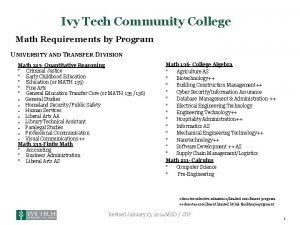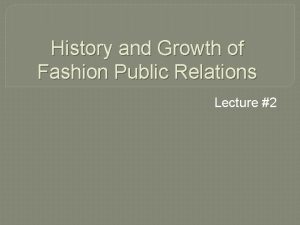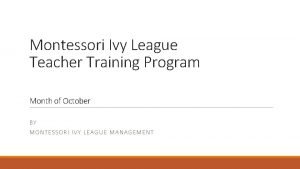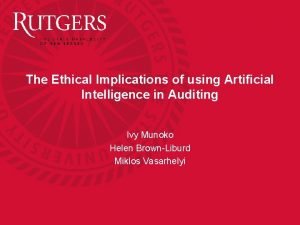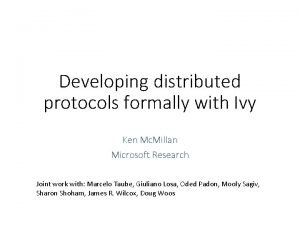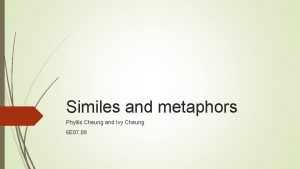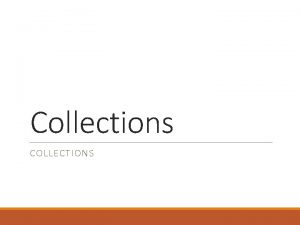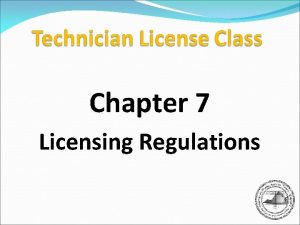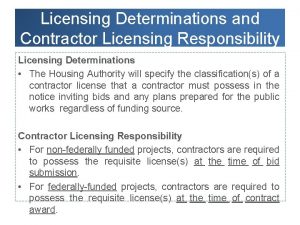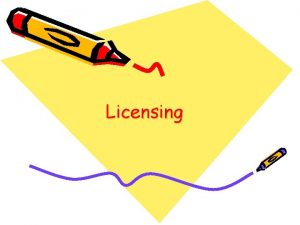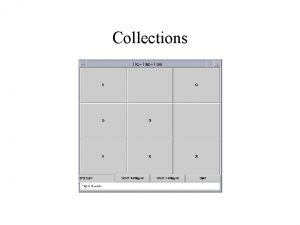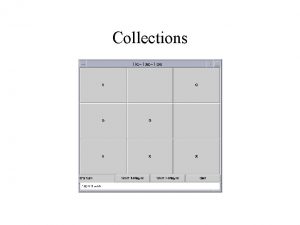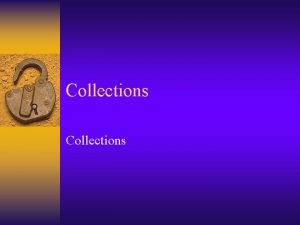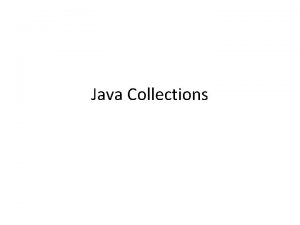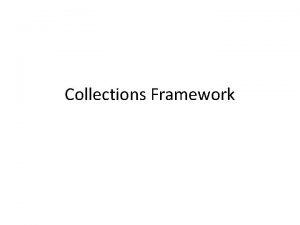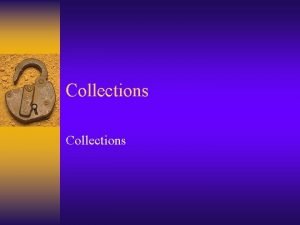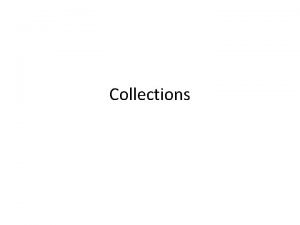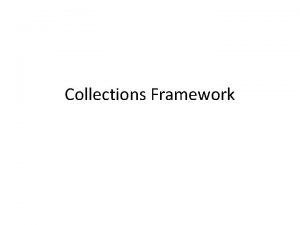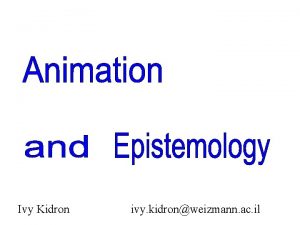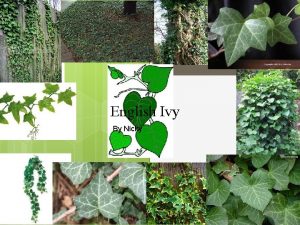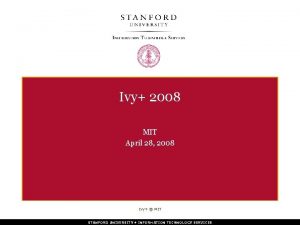CDL Licensing Update Ivy Anderson Director of Collections





































- Slides: 37

CDL Licensing Update Ivy Anderson Director of Collections California Digital Library SLASIAC Meeting February 25, 2013

Topics I’ll Cover • Context – Budget challenges – Metrics-based approach to journal evaluation and negotiation • Licensing update – Journals – Ebooks

Budget Challenges

UC Library materials budgets have essentially been flat for nearly a decade Adjusted Library Materials Budget 2000 - 2011 $70, 000 $60, 000 $50, 000 $40, 000 $30, 000 $20, 000 $10, 000 $0 2 1 00 2 0/ 00 02 01 20 0 /2 03 02 20 0 /2 04 0 20 20 3/ 20 04 5 00 2 / 20 05 6 00 2 / 20 06 7 00 2 / 20 07 8 00 2 / 20 08 0 /2 09 20 09 0 /2 10 20 10 0 /2 11

At the same time, journal expenditures have continued to far outpace library budgets, defying marketplace logic. Why?

The growth of active, peer reviewed learned journals since 1665 The problem of cost control for journals is due in part to the steady increase in research publication over time, which has averaged 3%+ per year over very long timeframes (Mabe, 2003)

…which, in turn, is correlated with the growth in numbers of researchers (Mabe 2004, based on data from ISI and NSF)

Bergstrom: Hell’s Grocery Aspesi: A Shift of Power • Big Deals reinforce publisher monopolies • Strategy: license more selectively, bargain hard, or walk away • Library budget crises and usage-driven value assessment will undermine big deals • This will adversely affect the fortunes (and profits) of large commercial publishers

UC Licensing Strategies

Where UC excels • Power of ten: UC’s reputation and market power deployed to advantage • Negotiating prowess: Consistently superior outcomes • Analytical rigor: Multi-factored value analyses inform negotiating goals and positions • Faculty engagement: Work regularly with UCOLASC • Transformative reach: Pursuit of novel arrangements that foster change

Examples of UC’s licensing effectiveness • Elsevier: – 10% savings over 5 years compared with extension of previous contract, with 39% more journal content – Total negotiated savings and cost avoidance: $6 -7 M – UCSB economist Ted Bergstrom’s analysis of Elsevier big deals found that UC had the best price among its peers – Unit cost per journal for systemwide (10 -campus) access: $4, 784 – Cost per use: $1. 01 (less than our cost per use for UC Press journals) • Nature Publishing Group: – UC successfully beat back an attempt by NPG to quadruple UC’s pricing for NPG journals – It’s currently recognized that UC has the best pricing of any institution – Price per use for Nature: $. 02 – Anne Kenney, Cornell, in CHE: "it was pretty shocking to me that they were getting such a great deal. “ – The saga isn’t over – we’re still in discussions

Examples of UC’s licensing effectiveness • Other major journal publishers – CDL journal licenses typically have a ‘multiplier’ of 2. 5 - 4 (i. e. UC pays for 2 -4 copies, not 10 copies), with access to all journals available at all campuses – 0% price caps over multiple years with many publishers – Result: • Springer license: UC subscription fees are now 65% below list price – Purchasing these journals at all campuses at list price would exceed the total collections budget of all ten UC campuses • 2006 Wiley analysis showed that access to Wiley journals would plunge by 75%-95% at each campus if our consortial license were cancelled – 15% negotiated reduction in base license fee with one journal publisher during the height of the budget crisis (similar reductions with other publishers via cancellation) • Compared to local campus licensing – One campus library has reported paying an average of $342 per title for non. CDL journal subscriptions that it licenses on its own, whereas that same campus’s average cost per CDL-licensed journal title is $69. By this measure, every $1. 00 spent on shared journal collections produces $4. 00 in savings for the campus.

Transformative Reach • UC-Springer Open Access pilot 2008 -2010 – only such arrangement in the U. S. (discontinued by publisher) • Nature Publishing Group – ongoing joint discussions have influenced NPG’s approach to open access • UC-wide open access discount agreements with PLo. S and other OA publishers • New: UC Libraries open access fund pilots at each campus provide direct support for faculty OA publishing – Seed funding provided by CDL • CDL model license – a gold standard adopted by many other institutions • New: Author rights clause negotiated in CDL licensing agreements

Successes in 2010 -2012 • 15% reductions ($2 million) achieved in base cost for selected major products • 0% increases for nearly 90 resources • Most others @ 3% or less (with some exceptions)

But, we have to do more…

CDL licensing efficiencies vs. library budget challenges CDL e-Journal Licensing Efficiency vs. Budget Gap Over 6 Years 50% 45% Cumulative Percent Invreases in Costs 40% 35% 30% 25% Publisher List Price (Library Journal Survey)--Average 7% annual increase for e-journals CDL Negotiated Cost for Major Publishers-Average 3% annual increase UC Libraries Material Budget---Average 1% annual increase Cost Efficiency: 25% savings over 6 years through consortial licensing and negotiation 20% 15% 10% 5% 0% -5% Budget Gap: 14% gap between costs and UC library budgets

Major Negotiations in 2012 • ACS Web Editions • CRC Press journals, CRCnetbases (Taylor & Francis) • Karger journals • Lippincott, Williams & Wilkins journals • Springer journals and ebooks • Taylor & Francis journals • Thomson ISI – Web of Science, Biosis, INSPEC • Wiley journals and ebooks

Prior to Major Negotiations: Journal Evaluation Project http: //www. cdlib. org/services/collections /protected/journalevaluation/index. html 13


Intended Outcomes • Improve our ability to make consortial decisions across the entire collection of collaboratively-licensed journals • Simplify the process for evaluating and managing journal titles • Prepare for multi-year contracts on a longer time horizon to better anticipate and plan for negotiation challenges and desired outcomes • Develop a shared knowledge base for consortial licensing goals, including treatment of niche titles, and relationship between local and systemwide licensing – Develop agreed-upon strategies for licensing titles outside of systemwide packages • Explore the potential for utilizing the title level data to arrive at a better value-based price for journal packages

Approach: Holistic Review of CDL-Licensed Journals using CDL Weighted Value Algorithm • How much value does UC derive from each journal that we license systemwide compared to other journals in the same discipline? • Key Features: – Analyzed all 8, 000 CDL-licensed journals according to 3 vectors of value • Utility • Quality • Cost-Effectiveness – Accounts for disciplinary differences through subjectspecific benchmarks – Numerical score with simple value designations • High, medium, low, ‘lowest’ Measurement Category Total Score Metrics Utility 0 -3 UC usage UC citations Quality 0 -2 SNIP Impact Factor Cost Effectiveness 0 -2 Cost per Use Cost per SNIP Journals are compared across more than 160 subjects

Disciplinary differences matter

S l n ocie of M M ty e a Na th of dic em R in tu h e re P BM N atic eolo ub J at al g lis Pu ur So y h b e Ac ing lish Pu ciet ou - in bli y st Ac g G sh ica ad r in Am l S em ou g p o er N at Co cie ic Jo Ltd ica i t m on u y n As a p o rn so A l Ac any f Am als cia me ad of tio ric em Bi eric Am n an y olo a er of C o ica P he f S gist hy m ci s n sic ic en As ist al ce so cia s i So s n cie tio M n ed ty A fo m ici r th er BM n T i e c hi e A an J P e d m ub Am v Ph a e lis y E hi eric nce sic lsev Un ng an me al ie ive Gr G nt Soc r rs ou eop of iet Am ity p er - h Sc y ica A of Sp ysic ien n m Chi eci al ce As er ca alt Un so ica go y io cia n P Jou n tio Ins res rn n titu s ( als fo J r C te o STO an f P R) ce hy r R si Ro ese cs ya ar Du l S ch oc k Ox e U ie ty n Ro for iv L e d ya U rs W Un ive O l So ni ity W rs pt cie ver Pr ity ic s e o al S ty o ity ss f C o f Pr al cie Ch es ifo ty em s Am rn o er ia f A istry ica n Ins Pre me So M ti ss ric et tu (J a cie ty E eor te o STO o lec ol f R f E tr og Ph ) xp oc ic ys lo he al ics ra m So tio ic ci n al ety Am N Ge So er atio op cie ica n hy ty n al R sic As ist so ese W s cia ar ile c y tio h -B IE Co la EE n Am of un ck er Ph cil we y C l i Ps can sics an l yc V T ad AR ac ea a TI uum ch CL e E S rs SA S (P oci GE ro ety P Qu ub e s Pr lica t) oj tio e ct ns M M ar y A US Ca E nn m Li M br e be IT id ge rt U I ni B nc. ve io rs On ity e ca Publisher Rankings by Journal Value Score 8. 00 7. 00 6. 00 5. 00 4. 00 3. 00 2. 00 1. 00 0. 00

fo A di ci r t me he ric Th ne a A J P ie m ub Am dv n Ph an y El e lis hi eric ce sic sev Un ng an me al ie ive Gr G nt Soc r rs ou eop of iet Am ity p er - h Sc y ica A of Sp ysic ien e C n m hi ci al ce As er ca alt Un so ica go y io cia n P Jou n tio Ins res rn n titu s ( als fo J r C te o STO an f P R) ce hy r R si Ro ese cs ya ar Du l S ch oc ke Ox U ie ty Ro for niv ya d U ers LW Un ive O l So ni ity W rs pt cie ver Pr ity ic s e o al S ty o ity ss f C o f Pr al cie Ch es ifo ty em s Am rn o er ia f A istry ica n Ins Pre me So M ti ss ric et tu (J a cie ty E eor te o STO o lec ol f R f E tr og Ph ) xp oc ic ys lo he al ics ra m So tio ic ci n al ety Am N Ge So a er tio op cie ica n hy ty n al R sic As e ist so se W s cia ar ile tio ch y-B IE E C Am n of oun lack E er Ph cil we y C l i Ps can sics an l yc V T ad AR ac ea a TI uum ch CL e E S rs SA S (P oci GE ro ety P Qu ub e s Pr lica t) oj tio ec n M t M s ar y A US Ca E nn m Lie M br be IT id ge rt U I ni B nc. ve io rs On it e S. y P Sp Kar ress AC rin ge M ge r A El D r-V G s igi e ev De ta rla i e Gr r F l L g uy ib r e te ra e do r ( ry In Be m te rn rk T Co SP I e a at io La ley ylo llec E na se E r & tio l l C r I ec F n en ns tro ra tre titu ni nc fo te c P is r D of res iff Am s) ra ct eric io n a Da ta BM Publisher Rankings by Journal Value Score

Higher Value Publishers American Chemical Society Lowest 5% LWW Lowest % 4% Low % 15% Medium 14% High % 49% High 81% Medium % 32%

Lower Value Publishers Taylor and Francis Karger High; 4; 5% High; 86; 9% Lowest; 13; 17% Medium, 202, 20% Lowest, 435, 43% Low, 276, 28% Medium; 28; 36% Low; 33; 42%

Ed ol og yc h Jo u uc y & ati rn on C al P ism o oun l i tr & tic Ed Co al S ies uc c m m ien at un ce io n, Sp icat ec ion ia l T s In op te rn ic L En atio iter s a vir n on al R ture m el en a ta tion l Ec s on Scie Re om nce cr i ea c H s tio ist o Ge n & ry nd Sp er or St ts ud R e ie s & ligi Se on xu al ity M H ilit ist ar or y & y N Cr av L im al aw Sc in Ph ol C og om ienc ilo y, lo e gy mu Pe ni & no Li tie lo s n gy & So guis c Ju t i ve al S ics cie ni le D nce el in s q So Ph ue. cia i lo. . l W Pu sop el b fa hy re lic He & So a cia lth l W o Ag ri rk An cult Co thr ure o m Lib pu pol t er ogy So rary E cia & con Sci e I o l C ha nfo mic nce T ng rm h a e & tio eor n y So cia Sci l C enc on e di tio ns ns gio Re Ps T&F Usage Comparison in Largest 29 Subjects Covering two thirds of T&F Titles Median Usage Comparison Between T&F Journals and All the Other Publishers by Subject: Usage is consistently low for T&F compared to other publishers 1600 1400 1200 1000 800 600 400 200 0 TF All the Other Publishers

gio Re ho lo E du gy Jo n ur s & ca na C tion lis P o o m lit un Ed & C ica trie uc om l Sc s at i io mu enc n, ni Sp ca e ec tio ia ns In l T te op rn L En at ite ics i vir on ra on al tu m Re re en la t Ec tal S ion on ci s Re om en c cr ea ic H es t i Ge s io n tor nd & y er Sp St o rt ud ie Re s s & lig Se ion xu al it M ilit Hi y st ar or y & y N Cr av im L a al in S w Ph ol og ilo Com cien y, lo gy mu ce Pe & n no Li itie lo n s gy & Soc guis i Ju al t ve Sc ics ie ni n le D ces e So lin cia Ph qu l W. . il P os. el fa ub oph re lic & H y So ea cia lth l Ag Wo rk r An icul Co th tur m rop e Lib pu So rar t ol cia y & Eco er S ogy c l C n ha Info om ienc ng rm ic T e e & atio heo So n r cia Sc y i e l C on nce di tio ns yc Ps T&F Cost Per Use Comparison in Largest 29 Subjects Covering two thirds of T&F Titles Average Cost Per Use Comparison Between T&F Journals and All Other Publishers by Subject Cost per use is consistently high for T&F compared to other publishers 12 10 8 6 4 2 0 TF All the Other Publishers

Goals for our T&F and Karger Contracts • CDL Goal: Try to preserve these agreements with a reduced spend that adjusts cost to value – T&F is a major publisher, with a strong list in some disciplines, but its pricing is not competitive for the level of use and impact its journals attract – Karger is a small, privately-held specialty biomedical publisher with quality journals in several areas – contributes to diversity in the marketplace • T&F Status – Awaiting final proposal – Fallback 1: Scale back to a much smaller package combined with local subscriptions – Fallback 2: Cancel the systemwide license, revert to campus-only subscriptions • Campuses have carefully reviewed T&F journals to determine which titles to retain locally if we walk away • Karger Status – Publisher has agreed to a price reduction

e. Books • Springer complete collection, 2012 • Wiley online library, 2012 • SIAM e-library, all series (400 titles) • Royal Society of Chemistry ebooks (1968 -2012)

More ebook offerings under consideration • ARL collaborative licensing initiative • Attempting to establish standards and appropriate pricing for university press ebook licensing • CDL sits on ARL’s advisory committee • New university press offerings under consideration – – Project Muse University Press Consortium Harvard University Press (via De Gruyter) Books@JSTOR Oxford University Press Scholarship Online • Other – CRC Press – Open access ebooks? ? • Knowledge Unlatched -- A new initiative by the former head of Bloomsbury Press to foster library investment in open access monographs from university presses

e. Books present many new issues • Packages vs. selective (‘demand-driven’) approaches? • Packages are cost-effective on a per-title basis but have the same weaknesses as journal big deals – large fixed expenditures with annual increases as publisher output grows • • • Inclusion of course-adoption titles? Integration with approval vendors and plans? Access on mobile devices? ILL rights vs. paid short-term loan? Relationship to print, print-on-demand? – If users continue to want print, will this require a duplicative expenditure?


Typical user comment • “I answered that I prefer print books, generally. However, the better answer would be that print books are better in some situations, while e-books are better in others. Each have their role – e-books are great for assessing the book, relatively quick searches, like encyclopedias or fact checking, checking bibliography for citations, and reading selected chapters or the introduction. If I want to read the entire book, I prefer print. If I want to interact extensively with the text, I would buy the book to mark up with my annotations; if I want to read for background (not as intensively) I will check out a print book from the library if possible. All options have their place. I am in humanities/social sciences, so print is still very much a part of my research life at this point. ” (Graduate Student, Humanities, Social Sciences)

Complementarity • “I use e-books primarily to determine if the content is going to be helpful to me – table of contents, index, or perhaps skimming a chapter or two. I dislike reading on a screen, and so if I conclude that I want to read the book, I borrow it through our library or ILL. ” (Faculty, Arts & Humanities) • “E-books are a convenience to see if I need that book. Once I have figured out that I do indeed need the book, I either go purchase it or borrow it from the library. ” (Undergraduate, Life & Health Sciences) • “I find that e-books are most useful when I need to find a bit of text quickly for a citation or to check whether or not a book will be useful to my work. E-books save me a trip to the library in these cases. But, I rarely read books online. The interface is clunky, my Internet is slow, and I am a better reader when I have the print copy in front of me. For me, e-books are another research tool but not a replacement for the print copy. ” (Graduate Student, Arts & Humanities)

UC Libraries Collection Development Committee is grappling with these issues and will be piloting several new approaches to ebook purchasing in 2013

Questions?
 Ivy anderson cdl
Ivy anderson cdl Immediate update and deferred update in dbms
Immediate update and deferred update in dbms Ordine cdl viterbo
Ordine cdl viterbo Eldt
Eldt Self certification affidavit texas
Self certification affidavit texas Alley dock backing
Alley dock backing Commercial drivers license michigan
Commercial drivers license michigan Cdl masking
Cdl masking Ivy day in the committee room analysis
Ivy day in the committee room analysis Bleeding time
Bleeding time Ivy plugin
Ivy plugin What is standard error in statistics
What is standard error in statistics Ivy league executive education
Ivy league executive education Gim ivy
Gim ivy Ivy method procedure
Ivy method procedure Ivy mike test
Ivy mike test Twjit
Twjit Aaliyah ivy
Aaliyah ivy Ivy morales
Ivy morales Ivy league archery
Ivy league archery Poison oak adaptations
Poison oak adaptations Ivy tech employee handbook
Ivy tech employee handbook Wake tech advising
Wake tech advising Ivy method procedure
Ivy method procedure Sherry
Sherry Night of the twisters book summary
Night of the twisters book summary Bepic
Bepic The passionate shepherd to his love analysis
The passionate shepherd to his love analysis Ivy munoko
Ivy munoko Ivy schuckert
Ivy schuckert Finite math ivy tech
Finite math ivy tech Ivy ledbetter lee
Ivy ledbetter lee Poison oak adaptations
Poison oak adaptations Poison ivy leaves
Poison ivy leaves Montessori ivy league
Montessori ivy league Ivy munoko
Ivy munoko Ivy ken
Ivy ken Kitten simile
Kitten simile
